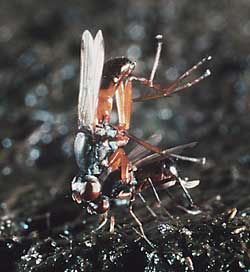European dung-fly females all aflutter for large males

European and North American dung flies differ in their mating frequency. (picture: UZH)<br>
This is what evolutionary ecologists from the University of Zurich discovered when they compared North American and European dung flies, which not only differ in sexual size dimorphism (SSD), but also in their mating behavior.
European and North American black scavenger flies – also called dung flies as their larvae develop in the feces of vertebrates and thus break them down – belong to the same species. Nevertheless, they strongly differ in mating behavior and SSD. North American dung fly females are larger than males, the usual dimorphism in insects. European dung flies, however, are more unusual with males being considerably larger than females.
In evolutionary biology, sexual selection for large males can be explained if they can reproduce more successfully than smaller ones, either because females prefer larger males or because the latter prevail more often in the competition for mates with other males. Evolutionary ecologists from the University of Zurich showed that female preference for large males is far greater in European fly populations than in their North American counterparts, which explains the different SSD.
Different mating behavior
North American dung fly males woo the females with a courtship dance. Project leader Wolf Blanckenhorn does not rule out the possibility that North American males also deploy pheromone-like scents during courtship. This courtship dance is entirely absent in the European flies: males mount the females relatively randomly, cling onto them with varying degrees of success and try to mate with them, even though they are often shaken off again by the females before copulation.
European dung flies copulate more often
European and North American dung flies also differ in their mating frequency. During their roughly 40-day adult life, European dung flies mate often, their North American counterparts only once or twice. “Frequent copulation requires more sperm from the males and therefore larger testes,” explains Blanckenhorn. This could well be a contributory factor in the European females’ greater preference for large males. However, the connection between the continental differences in SSD and mating behavior is still unclear: “What is an evolutionary cause and what an effect can only – if at all – be reconstructed indirectly today,” concludes Blanckenhorn.
Literature:
Nalini Puniamoorthy, Martin A. Schäfer and Wolf U. Blanckenhorn. Sexual Selection Account for the Geographic Reversal of Sexual Size Dimorphism in the Dung Fly Sepsis Punctum (Diptera: Sepsidae). Journal Evolution. March 16, 2012. doi:10.1111/j.1558-5646.2012.01599.x
Contact:
Prof. Dr. Wolf Blanckenhorn
Institute of Evolutionary Biology and Environmental Studies
University of Zurich
Tel.: +41 44 635 47 55
Email: wolf.blanckenhorn@ieu.uzh.ch
Media Contact
More Information:
http://www.uzh.chAll latest news from the category: Life Sciences and Chemistry
Articles and reports from the Life Sciences and chemistry area deal with applied and basic research into modern biology, chemistry and human medicine.
Valuable information can be found on a range of life sciences fields including bacteriology, biochemistry, bionics, bioinformatics, biophysics, biotechnology, genetics, geobotany, human biology, marine biology, microbiology, molecular biology, cellular biology, zoology, bioinorganic chemistry, microchemistry and environmental chemistry.
Newest articles

Properties of new materials for microchips
… can now be measured well. Reseachers of Delft University of Technology demonstrated measuring performance properties of ultrathin silicon membranes. Making ever smaller and more powerful chips requires new ultrathin…

Floating solar’s potential
… to support sustainable development by addressing climate, water, and energy goals holistically. A new study published this week in Nature Energy raises the potential for floating solar photovoltaics (FPV)…

Skyrmions move at record speeds
… a step towards the computing of the future. An international research team led by scientists from the CNRS1 has discovered that the magnetic nanobubbles2 known as skyrmions can be…





















